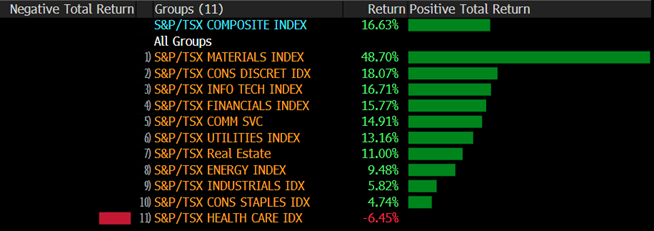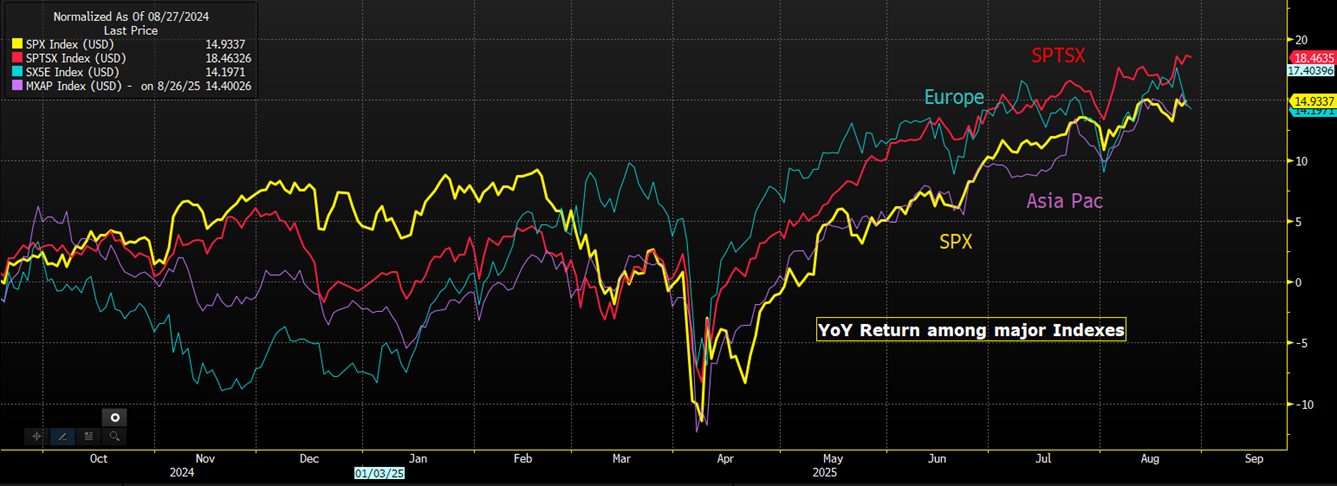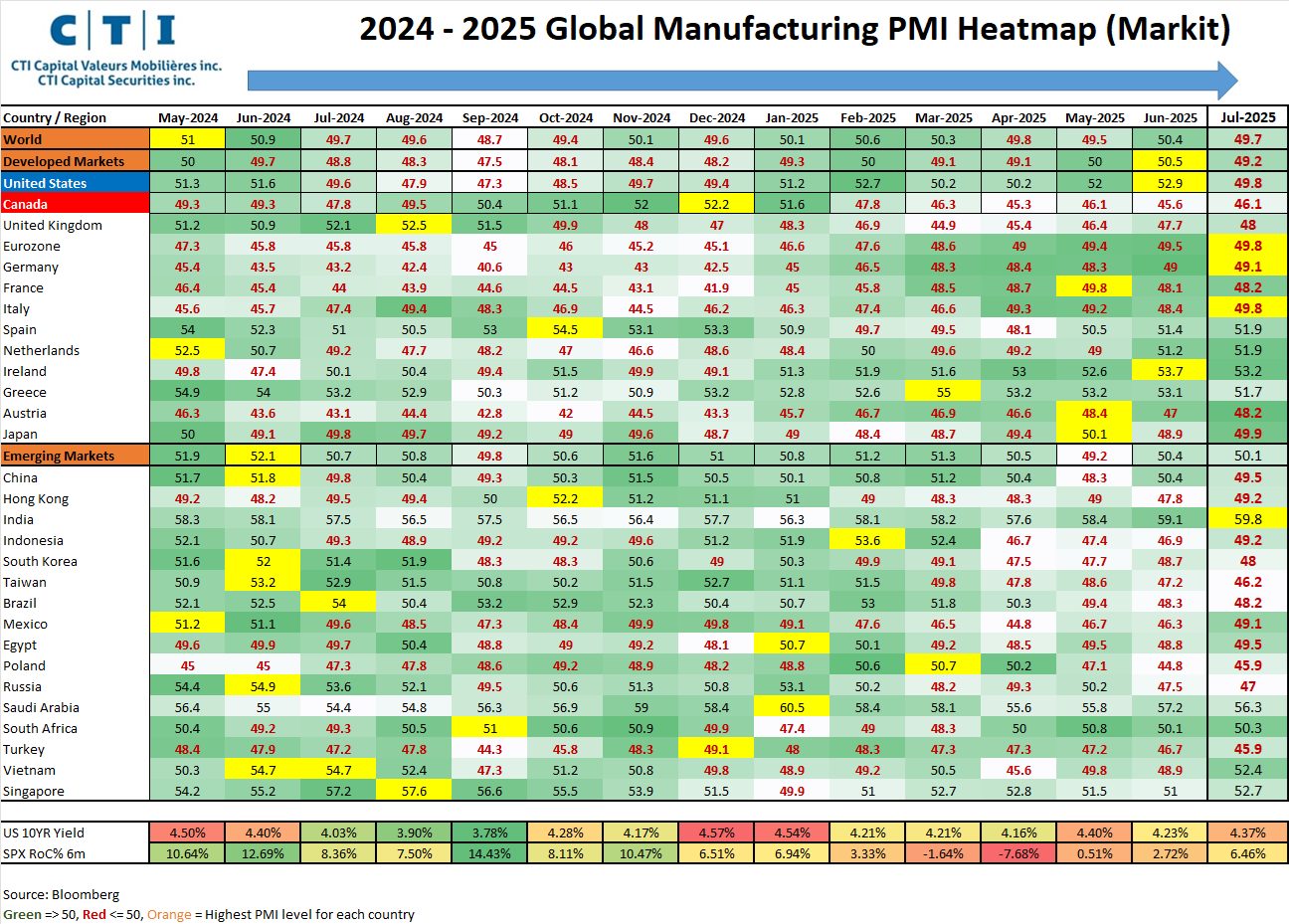Commentaires
Revue Mensuelle du Marché : Août 2025
Aperçu
La revue mensuelle de CTI Capital observe que les marchés ont abordé août avec prudence après des gains records en juillet. Les premières faiblesses venaient de données d’emploi décevantes, d’inquiétudes tarifaires et de la hausse des rendements obligataires. Toutefois, la solidité des résultats corporatifs et l’anticipation d’un assouplissement monétaire de la Réserve fédérale ont permis de stabiliser le climat.
États-Unis : Performance et Politique
Le 1er août, le Dow Jones a perdu 500 points, mais le S&P 500 est resté plus de 25 % au-dessus de ses creux d’avril et le Nasdaq plus de 35 % plus haut, soutenus par Microsoft, Meta et d’autres géants.
Les marchés à terme intégraient près de 89 % de probabilité d’une baisse de taux en septembre.
Données clés (FRED) :
- Taux des fonds fédéraux : 4,33 %
- Chômage : 4,2 %
- M2 : 22,1 billions USD
La confiance des ménages a reculé à 97,4, tandis que les attentes d’inflation atteignaient 6,2 % sur les biens essentiels. Les rachats d’actions ont dépassé 1 000 milliards USD, menés par Apple, Alphabet et JPMorgan. L’activité manufacturière a atteint 53,3 et les services 55,4, signalant une expansion malgré des coûts élevés.
Canada : Marché et Politique
L’indice composé S&P/TSX est demeuré près de 22 500. Le recul du pétrole sous 77 USD a pesé sur les ressources, mais les banques et les infrastructures ont soutenu l’ensemble.
BNN Bloomberg a souligné l’attention portée à la Banque du Canada : les marchés anticipent une baisse de taux en octobre, l’inflation se modérant. L’immobilier s’est stabilisé, avec une reprise des ventes en Ontario et en Colombie-Britannique malgré des taux hypothécaires élevés.
Le Globe and Mail note des résultats bancaires solides, soutenus par des ratios de capital robustes et une qualité du crédit stable. Les investissements en technologie et infrastructures compensent les pressions liées aux matières premières, favorisant une croissance modérée.
Perspectives
Aux États-Unis, les bénéfices solides et la perspective d’un assouplissement nourrissent un optimisme prudent. Au Canada, la résilience des banques et la flexibilité monétaire offrent un soutien, même si l’énergie et le commerce restent à surveiller.



Reading the Fed’s Dot Plot vs. Market Odds
Executive Summary
The June 2025 Summary of Economic Projections (SEP) shows a median policy path that edges down gradually: federal funds rate medians of 3.9% (end-2025), 3.6% (2026), 3.4% (2027), and a 3.0% longer-run estimate. Inflation remains above target in 2025 but converges toward 2% by 2027. Markets, meanwhile, are pricing a high probability of a 25 bps cut in September and additional easing into year-end. Recent Fed commentary has turned more open to easing, with Governor Waller saying “the time has come to ease” and President Williams signaling it will be “appropriate to move interest rates toward a more neutral stance over time.”
1) What the Dot Plot Says Now
The SEP’s dot plot aggregates individual FOMC participants’ judgments for the appropriate fed funds rate. The medians imply a measured glide-path:
-
Fed funds rate (median): 3.9% (2025) → 3.6% (2026) → 3.4% (2027) → 3.0% longer run.
-
Macro medians: Real GDP: 1.4% (2025), 1.6% (2026), 1.8% (2027). Unemployment: 4.5% (2025), 4.5% (2026), 4.4% (2027). PCE inflation: 3.0% (2025), 2.4% (2026), 2.1% (2027).
-
Core PCE: 3.1% (2025), 2.4% (2026), 2.1% (2027) (central tendency).
These medians summarize a Committee that expects disinflation to continue but sees convergence to 2% as a multi-year process, hence a gradual reduction in policy rates rather than an abrupt pivot. Federal Reserve
Why this matters: the dots are policy-appropriate paths, not unconditional forecasts. They incorporate each participant’s reaction function—how policy should evolve if the economy follows their baseline. That’s why the dots can differ from market pricing, which reflects a probability-weighted view of many possible states.
2) 2026: What the Dots Are Signaling
For 2026, the median path to 3.6% sits ~30 bps below the 2025 median, consistent with a slow normalization as inflation trends toward ~2.4% PCE and unemployment stays near 4½%. Put simply: the Committee anticipates restrictive → less restrictive, not an immediate jump to neutral. The longer-run median at 3.0% anchors where policy might settle once inflation is durably at target and the economy is near equilibrium.
3) What Fed Officials Are Saying
-
Christopher J. Waller (Aug 28, 2025): “The time has come to ease monetary policy and move it to a more neutral stance… I would support a 25 bp cut at the Committee’s September meeting,” noting underlying inflation near 2% (excluding temporary tariff effects) and rising downside risks in the labor market.
-
John C. Williams (Sep 4, 2025): With inflation still above 2% but cooling, he expects it will be “appropriate to move interest rates toward a more neutral stance over time,” and laid out a path where PCE inflation runs 3.0%–3.25% in 2025, ~2½% in 2026, and 2% in 2027.
Read-through: These remarks are directionally consistent with the SEP medians: measured easing as inflation normalizes and growth cools, with explicit caution around tariff effects and labor-market softness.
4) Market-Implied Probabilities (CME FedWatch + Atlanta Fed MPT)
Near-term odds: Interest-rate derivatives now reflect near-certainty of a September cut, with a non-zero tail for a larger move. For example, real-time coverage today notes ~12% odds of a 50 bps move after weak payrolls, while multiple outlets flag ~95%+ odds of at least 25 bps.
Year-end pricing: As of early September, one widely tracked FedWatch aggregation places ~45.5% probability on a 3.75%–4.00% target range by December 2025, implying roughly two 25 bp cuts by year-end. Use the CME FedWatch Tool for the latest official probabilities at each meeting.
Path distributions: The Atlanta Fed Market Probability Tracker provides a complementary, options-implied distribution of SOFR-linked policy paths, useful for assessing the shape and skew of the expected rate trajectory into 2026.
5) Reconciling Dots vs. Markets
-
Convergence: The market’s baseline—a cut in September and another by year-end—doesn’t conflict with the SEP’s 3.9% (2025) → 3.6% (2026) trajectory; it simply front-loads the initial step(s) given recent data.
-
Remaining gaps: The SEP embeds a conditional policy path (if the Fed’s macro baseline holds). Markets incorporate probabilities of weaker growth/labor and tariff-driven inflation noise fading, which—especially after soft payroll revisions—pushes pricing toward earlier easing.
6) What to Watch Next
-
Data-dependence: Payroll revisions, core PCE momentum, and evidence that tariff pass-through is temporary will drive the cadence of cuts. Federal Reserve
-
SEP updates: Each new SEP can re-anchor the median path; compare the dots to meeting-by-meeting FedWatch probabilities to monitor divergence.
-
Term structure of odds: Use the Atlanta Fed tracker to gauge whether the tail risks into 2026 are skewing lower or higher than the dot-plot medians imply.
Bottom Line
-
The June 2025 dots imply gradual easing through 2026 as inflation drifts toward 2% and growth remains moderate.
-
Officials’ rhetoric (Waller, Williams) has opened the door to near-term cuts while emphasizing neutral-ward policy, consistent with the SEP medians.
-
Markets price a September cut with high confidence and two cuts by year-end as a baseline, broadly compatible with the Fed’s 2026 median rate of 3.6%—but more front-loaded than the dots alone would suggest.
26/08/2025 – Global Manufacturing PMI Heatmap (Markit)
